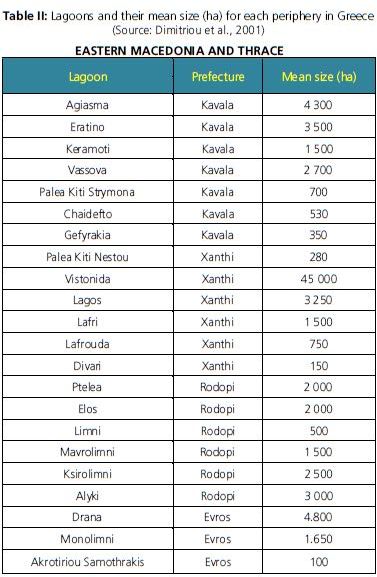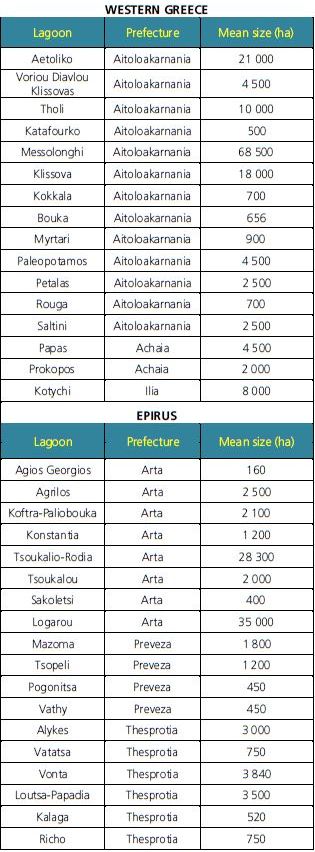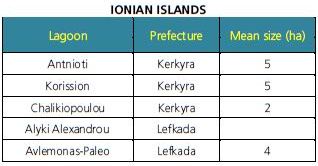5.2 Generalities on coastal lagoons
Divergent views about the number of lagoons in Greece exist. Heliotis (1984) identifies 37 lagoons, whereas a major wetland inventory lists 60 lagoons, covering an area of about 288 km2 (approximately 14 percent of all Greek wetlands) (Zalidis and Mantzavelas, 1994). An unpublished inventory records 76 lagoons covering 34 500 ha without comprising the lagoons located in the Aegean islands (Dimitriou et al., 2001).
The most extensive lagoon systems are located in western and northern Greece (Fig. 1). The largest lagoon is the Messolonghi complex located in western Greece, comprising six lagoons. The Messolonghi lagoon system covers about 15 000 ha. The most important systems are protected under the Ramsar Convention or are part of the Natura 2000 network and almost all are used for extensive fish culture.
1 Administrative division of Greece 
Figure 1. The main lagoon systems in Greece
Table II shows the total number of lagoons and their mean size for each periphery in Greece. It should be noted that the number of the lagoons and their size reported at the various inventories listing the lagoons in Greece is not exhaustive and some size data may be an approximate estimation. Moreover, many small lagoons are not inventoried and some are not included in the protected areas.
Table II: Lagoons and their mean size (ha) for each periphery in Greece
(Source: Dimitriou et al., 2001)



IONIAN ISLANDS
Lagoon Prefecture Mean size (ha)
Antnioti Kerkyra 5
Korission Kerkyra 5
Chalikiopoulou Kerkyra 2
Alyki Alexandrou Lefkada
Avlemonas-Paleo Lefkada 4

In general, most lagoons in Greece are smaller than one hectare and have a mean depth smaller than 1 meter; only about 15 percent of the lagoons have a mean depth over one meter. All biological components show great variability both in space and time, which is attributed to environmental variability. The most important variable influencing species distribution and diversity is the degree of communication with the sea and the nutrient load introduced through freshwater inputs.
Coastal lagoon typologies
Based on the geo-morphological features and the degree of communication with the sea, the lagoons in Greece can be divided in two types: open and closed. Most lagoons (about 70 percent) are classified as closed ecosystems (Dimitriou et al., 2001), and are those separated from the sea by narrow barriers and communicating with the marine environment by artificial openings, allowing a limited water exchange. Moreover, almost 50 percent of them do not receive a direct freshwater input.
The lagoons are mainly used as extensive fish farms; they belong to the state and are managed by local regional authorities. Most of them are leased to local fishers’ cooperatives, and in a few 2 cases also to private companies. The management activities for fish production improvement inside the lagoons have been so far empirical, and were mostly based on traditional principles similar to the Italian vallicoltura (Tsihrintzis et al., 2007). Some interventions involve restocking with fry and constructions such as wintering channels or new openings for the improvement of water exchange. Wintering ditches are covered with nets in order to protect fish from cormorant attacks. Other activities in order to increase production in some lagoons of northern Greece and Amvrakikos Gulf led to the introduction of juveniles from commercial fisheries (i.e. seabream) (Koutrakis et al., 2007).
In many cases, the lagoons which are exploited by fishers can be in a better environmental state than those leased to the private companies (Koutrakis, 2005). However, in other cases (e.g. Papas lagoon), overexploitation and mismanagement of the system enhance eutrophication phenomena and may lead to dystrophic crises (Reizopoulou and Nicolaidou, 2007).
Legal framework and constraints
The most important systems are protected under the Ramsar Convention and/or are part of the Natura 2000 network. The large part of the ecosystems is considered as an Important Bird Areas (IBA) covered by Wildlife Refuge, other systems are included in Special Protection Areas and/or Sites of Community Importance (e.g. Amvrakikos), whereas the Messolonghi lagoon complex is part of a Marine Protected Area (MPA), which is the most recent MPA in Greece, established in 2006, as National Park of Messolonghi–Aetoliko Lagoons, Estuaries of Acheloos and Evinos and Echinades Islands.